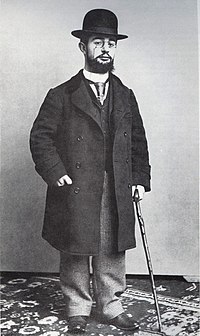
Photo from wikipedia
Rationale: Pycnodysostosis is a rare autosomal recessive skeletal dysplasia characterized by short stature, craniofacial dysmorphism, acro-osteolysis, osteosclerosis, and brittle bone with poor healing. Pycnodysostosis results from the deficient activity of… Click to show full abstract
Rationale: Pycnodysostosis is a rare autosomal recessive skeletal dysplasia characterized by short stature, craniofacial dysmorphism, acro-osteolysis, osteosclerosis, and brittle bone with poor healing. Pycnodysostosis results from the deficient activity of cathepsin K, a lysosomal cysteine protease that is encoded by CTSK. Patient concerns: We report a Korean adult patient with pycnodysostosis and atypical femur fracture whose diagnosis was confirmed by next-generation sequencing (NGS) of candidate genes. A 41-year-old female patient was presented with a left femur fracture after falling down. Underlying sclerotic bone disease was suspected as a radiographic skeletal survey showed thickened cortical bones, and the total body bone density was increased (T score was 5.3, and Z score was 4.9). Diagnoses: We performed candidate gene sequencing of various sclerotic bone diseases for the differential molecular diagnosis of underlying sclerosing bone disease. Two heterozygous variants of CTSK were detected. One was a frameshift variant in exon 5, c.426delT (p.Phe142Leufs*19), which was previously reported, and the other was a novel missense variant in exon 6, c.755G>A (p.Ser252Asn). Sanger sequencing of CTSK confirmed the 2 heterozygous variants and thus the patient was diagnosed with pycnodysostosis. Interventions: The patient had emergency surgery for subtrochantic femoral fracture. Outcomes: After 4 months of surgery, the patient had almost a full range of hip and knee movements and radiographs show the substantial bridging callus across the fracture. Lessons: Candidate gene sequencing could be a useful diagnostic tool for the genetically heterogeneous skeletal dysplasia group, especially in cases with a mild or atypical clinical phenotype.
Journal Title: Medicine
Year Published: 2017
Link to full text (if available)
Share on Social Media: Sign Up to like & get
recommendations!